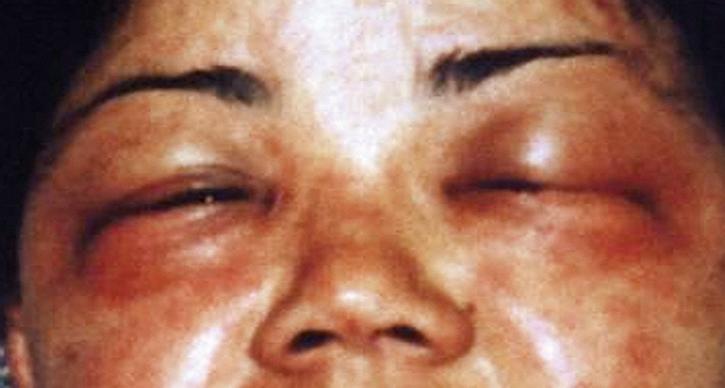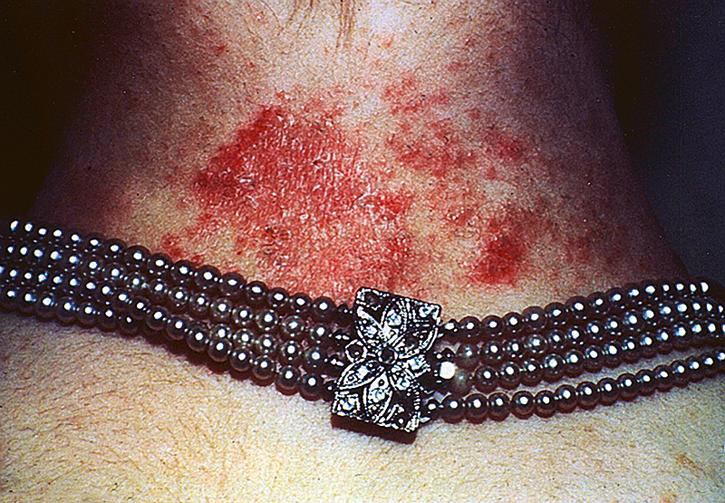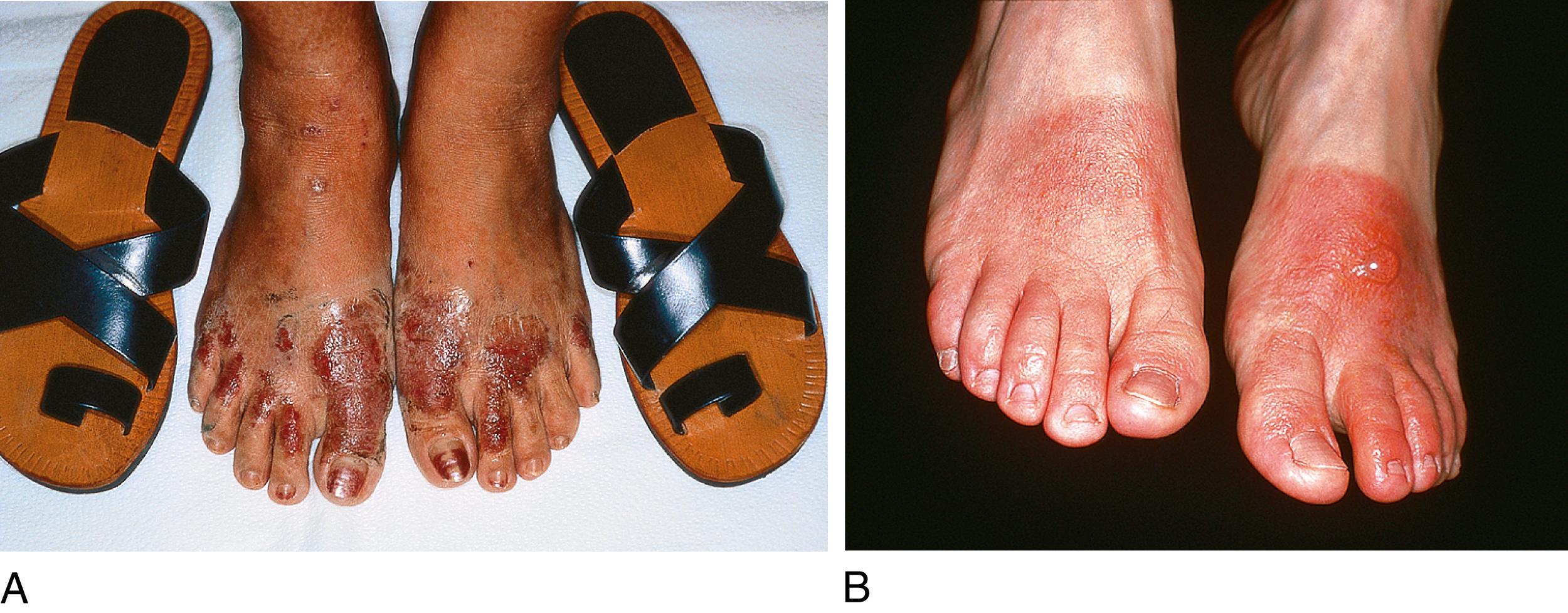Physical Address
304 North Cardinal St.
Dorchester Center, MA 02124
Patients present with a very pruritic, eczematous-like rash at sites of skin exposure to allergens. Lesions may consist of small papules, vesicles, or bullae that may be confluent. Inflammation may exist with erythema, edema, oozing, or crusting. Dermatitis may remain localized at contact sites or, in severe cases, can spread to involve distant body areas. Sites with thin skin (e.g., eyelids [ Fig. 162.1 ], lateral neck, dorsum of hands, genitals) show greater susceptibility, whereas areas with a thick stratum corneum (palms and soles) have more resistance. Because this is a delayed hypersensitivity reaction, the pruritus and rash may not become evident for 24 to 48 hours or longer after exposure to the allergenic substance. Although a substance new to the patient in the past few weeks is more likely to be the precipitating agent, patients have been known to react to products that they have been using for years.

The one uniformly present feature of allergic contact dermatitis (ACD) is pruritus, without which the diagnosis of ACD is virtually excluded.
![]() Attempt to determine the offending agent. Skin lesion distribution often provides a clue to the offending allergen. Question patients about potential exposure to topical medications (such as neomycin or benzocaine) or other potential allergens (such as sunscreens, moisturizing lotions, perfumes and other fragrances, nail polish, artificial nails, cosmetics, soaps, shampoos, hair dyes, household cleaners, laundry products, paints, rubbers, latex, adhesives, footwear, clothing, and plants such as poison ivy [ Rhus toxicodendron ]) (see Chapter 184 ). Metals in jewelry (e.g., nickel, chromium, cobalt) ( Fig. 162.2 ) and chemicals in clothing and footwear (e.g., resins, crease-resistant finishes, leather dyes, rubber accelerators) ( Fig. 162.3 ) can be sources of cutaneous allergens. Vulvitis and balanitis may occur in patients who have an allergy to latex in condoms or ingredients in douches, contraceptive jellies, feminine hygiene products, or toilet paper.
Attempt to determine the offending agent. Skin lesion distribution often provides a clue to the offending allergen. Question patients about potential exposure to topical medications (such as neomycin or benzocaine) or other potential allergens (such as sunscreens, moisturizing lotions, perfumes and other fragrances, nail polish, artificial nails, cosmetics, soaps, shampoos, hair dyes, household cleaners, laundry products, paints, rubbers, latex, adhesives, footwear, clothing, and plants such as poison ivy [ Rhus toxicodendron ]) (see Chapter 184 ). Metals in jewelry (e.g., nickel, chromium, cobalt) ( Fig. 162.2 ) and chemicals in clothing and footwear (e.g., resins, crease-resistant finishes, leather dyes, rubber accelerators) ( Fig. 162.3 ) can be sources of cutaneous allergens. Vulvitis and balanitis may occur in patients who have an allergy to latex in condoms or ingredients in douches, contraceptive jellies, feminine hygiene products, or toilet paper.


![]() Evaluate for possible occupational exposure. Industries in which workers are at the highest risk for occupational skin diseases include food production, construction, printing, metal plating, machine tool operation, engine service, leatherwork, health care, cosmetology, and forestry. Specific chemical agents encountered on the job may reveal the underlying cause.
Evaluate for possible occupational exposure. Industries in which workers are at the highest risk for occupational skin diseases include food production, construction, printing, metal plating, machine tool operation, engine service, leatherwork, health care, cosmetology, and forestry. Specific chemical agents encountered on the job may reveal the underlying cause.
![]() Examine the involved skin. The appearance of the lesions in ACD often corresponds to the stage at which the patient presents. During the acute stage , there is marked erythema, edema, and vesicle formation. Edema predominates in areas of loose connective tissue, such as the eyelids or genitalia. Vesicles are usually multiple, may coalesce, and eventually will rupture during the subacute stage , leading to oozing and eroded skin with a characteristic eczematous appearance. Vesicles may be replaced by papules, crusting and scaling become more prominent than the erythema and edema, and (over time) lichenification and further scaling predominate during the chronic stage . These stages often overlap, and there is no sharp delineation between them.
Examine the involved skin. The appearance of the lesions in ACD often corresponds to the stage at which the patient presents. During the acute stage , there is marked erythema, edema, and vesicle formation. Edema predominates in areas of loose connective tissue, such as the eyelids or genitalia. Vesicles are usually multiple, may coalesce, and eventually will rupture during the subacute stage , leading to oozing and eroded skin with a characteristic eczematous appearance. Vesicles may be replaced by papules, crusting and scaling become more prominent than the erythema and edema, and (over time) lichenification and further scaling predominate during the chronic stage . These stages often overlap, and there is no sharp delineation between them.
![]() Have the patient remove the offending allergen from the environment to avoid reexposure, and thoroughly wash the skin with a hypoallergenic soap.
Have the patient remove the offending allergen from the environment to avoid reexposure, and thoroughly wash the skin with a hypoallergenic soap.
![]() For acute reactions with significant edema and erythema, especially those with inflamed, oozing, or crusted lesions, supportive care with cold compresses soaked with aluminum acetate solution (Domeboro) has cooling, soothing, and antiseptic effects. Cool baths with starch or oatmeal (Aveeno) may also be soothing.
For acute reactions with significant edema and erythema, especially those with inflamed, oozing, or crusted lesions, supportive care with cold compresses soaked with aluminum acetate solution (Domeboro) has cooling, soothing, and antiseptic effects. Cool baths with starch or oatmeal (Aveeno) may also be soothing.
![]() For severe reactions, if there are no contraindications or relative contraindications (tuberculosis, peptic ulcer, diabetes, herpes, or severe hypertension), prescribe systemic corticosteroids, such as oral prednisone, 60 mg (or 1 mg/kg) for approximately 5 days, and then taper prednisone over at least 2 weeks.
For severe reactions, if there are no contraindications or relative contraindications (tuberculosis, peptic ulcer, diabetes, herpes, or severe hypertension), prescribe systemic corticosteroids, such as oral prednisone, 60 mg (or 1 mg/kg) for approximately 5 days, and then taper prednisone over at least 2 weeks.
![]() Systemic oral antihistamine therapy, such as hydroxyzine (Vistaril) or diphenhydramine (Benadryl), 25 to 50 mg up to four times per day, helps control pruritus. The benefits may be nominal in the delayed-type reactions of ACD, but any reduction in pruritus will be appreciated by the patient. The side effect of drowsiness may also be appreciated (especially at bedtime), but other potential deleterious side effects should also be considered when prescribing these medications.
Systemic oral antihistamine therapy, such as hydroxyzine (Vistaril) or diphenhydramine (Benadryl), 25 to 50 mg up to four times per day, helps control pruritus. The benefits may be nominal in the delayed-type reactions of ACD, but any reduction in pruritus will be appreciated by the patient. The side effect of drowsiness may also be appreciated (especially at bedtime), but other potential deleterious side effects should also be considered when prescribing these medications.
![]() For mild and localized reactions , topical corticosteroids have anti-inflammatory and antipruritic effects. They are usually effective within a few days and should be continued for 2 weeks. A low-potency preparation such as hydrocortisone 1% is adequate for many presentations. More severe local reactions can be treated with a midpotency steroid such as triamcinolone 0.05%, while the very potent topical steroids such as fluocinonide (Fluonex; Lidex) cream/ointment/gel 0.05% should be reserved for extremely severe presentations. Topical steroids may be potentiated with occlusive dressings. Avoid long-term use (>10–14 days) of fluorinated corticosteroids such as fluocinonide on the face and genitalia, where they can cause atrophy. In general, higher-potency steroids should be reserved for the extremities and torso.
For mild and localized reactions , topical corticosteroids have anti-inflammatory and antipruritic effects. They are usually effective within a few days and should be continued for 2 weeks. A low-potency preparation such as hydrocortisone 1% is adequate for many presentations. More severe local reactions can be treated with a midpotency steroid such as triamcinolone 0.05%, while the very potent topical steroids such as fluocinonide (Fluonex; Lidex) cream/ointment/gel 0.05% should be reserved for extremely severe presentations. Topical steroids may be potentiated with occlusive dressings. Avoid long-term use (>10–14 days) of fluorinated corticosteroids such as fluocinonide on the face and genitalia, where they can cause atrophy. In general, higher-potency steroids should be reserved for the extremities and torso.
![]() With respect to the delivery form of topical steroids, consider using gels only if the affected area is weeping and will benefit from the drying effect of a gel. Steroid creams may have greater cosmetic appeal than steroid ointments, but creams typically contain more potentially allergenic preservatives and fragrances. Ointments, on the other hand, penetrate more deeply into the skin, increasing their potency.
With respect to the delivery form of topical steroids, consider using gels only if the affected area is weeping and will benefit from the drying effect of a gel. Steroid creams may have greater cosmetic appeal than steroid ointments, but creams typically contain more potentially allergenic preservatives and fragrances. Ointments, on the other hand, penetrate more deeply into the skin, increasing their potency.
![]() When impetigo is present resulting from superimposed bacterial infection (see Chapter 174 ), treat with systemic antibiotics. First-line agents are cephalexin or dicloxacillin; erythromycin can be used in those with beta-lactam allergies. Consider antibiotics effective against community-acquired methicillin-resistant Staphylococcus aureus (MRSA) according to the patient’s risk factors. Avoid topical medications as these are frequent allergic sensitizers.
When impetigo is present resulting from superimposed bacterial infection (see Chapter 174 ), treat with systemic antibiotics. First-line agents are cephalexin or dicloxacillin; erythromycin can be used in those with beta-lactam allergies. Consider antibiotics effective against community-acquired methicillin-resistant Staphylococcus aureus (MRSA) according to the patient’s risk factors. Avoid topical medications as these are frequent allergic sensitizers.
![]() When a precipitating agent cannot be determined , the patient should be referred for epicutaneous patch testing, which is considered the gold standard for diagnosing ACD. If patch testing fails to incriminate a likely allergen and the diagnosis of ACD is still strongly considered, a detailed diary of the patient’s daily activities may help discover patterns of allergen exposure.
When a precipitating agent cannot be determined , the patient should be referred for epicutaneous patch testing, which is considered the gold standard for diagnosing ACD. If patch testing fails to incriminate a likely allergen and the diagnosis of ACD is still strongly considered, a detailed diary of the patient’s daily activities may help discover patterns of allergen exposure.
![]() When the allergen cannot be avoided , wearing protective barriers is the next best preventive option. Gloves may be the most effective means of allergen protection. Vinyl gloves are ideal for most applications—they are waterproof and can be worn atop cotton gloves for greater comfort.
When the allergen cannot be avoided , wearing protective barriers is the next best preventive option. Gloves may be the most effective means of allergen protection. Vinyl gloves are ideal for most applications—they are waterproof and can be worn atop cotton gloves for greater comfort.
![]() The offending objects may sometimes be modified to become less allergenic themselves, such as nickel-plated fasteners and jewelry that is painted with a clear polyurethane varnish.
The offending objects may sometimes be modified to become less allergenic themselves, such as nickel-plated fasteners and jewelry that is painted with a clear polyurethane varnish.
![]() Do not allow patients to apply fluorinated corticosteroids for more than 10 to 14 days to the face or genital area, as they can produce premature aging of the skin with thinning and striae.
Do not allow patients to apply fluorinated corticosteroids for more than 10 to 14 days to the face or genital area, as they can produce premature aging of the skin with thinning and striae.
![]() Do not prescribe a prepackaged steroid dose pack that is tapered over 6 days. It is usually inadequate for treatment of ACD (which will often last for ∼2 weeks) and frequently results in an apparent rebound dermatitis and patient dissatisfaction.
Do not prescribe a prepackaged steroid dose pack that is tapered over 6 days. It is usually inadequate for treatment of ACD (which will often last for ∼2 weeks) and frequently results in an apparent rebound dermatitis and patient dissatisfaction.
![]() Do not prescribe systemic steroids when secondary infections, such as cellulitis or erysipelas, are present. Also do not start steroids if there is a history of infectious disease or other systemic illness (e.g., diabetes) that makes systemic steroids a relative contraindication.
Do not prescribe systemic steroids when secondary infections, such as cellulitis or erysipelas, are present. Also do not start steroids if there is a history of infectious disease or other systemic illness (e.g., diabetes) that makes systemic steroids a relative contraindication.
![]() Do not recommend desensitization protocols (allergy shots). They have no role in treating delayed-type hypersensitivities to contact allergens.
Do not recommend desensitization protocols (allergy shots). They have no role in treating delayed-type hypersensitivities to contact allergens.
Allergic contact dermatitis is a delayed cutaneous hypersensitivity or cell-mediated immune reaction to small-molecular-weight chemicals, which act as haptens. To date, more than 3000 chemicals have been described to cause allergic dermatitis in human beings. Approximately 50 chemicals cause 80% of the reactions seen in clinical practice. ACD begins with a sensitization phase, in which these small molecules pass through the stratum corneum and are processed by Langerhans cells in the epidermis. Antigen-coupled Langerhans cells then leave the epidermis and migrate to the regional lymph nodes via the afferent lymphatics and present this antigen to naïve CD4+ T cells. These T cells proliferate into memory and effector T cells, which are capable of inducing ACD after repeat exposure to the allergen. Upon repeat exposure, the elicitation phase has a latency period that corresponds to the travel time for Langerhans cells to present the allergen to T cells plus the time for these T cells to proliferate, secrete cytokines, and home with other inflammatory cells to the site of contact. A contact allergic reaction normally appears 12 to 72 hours after exposure in a previously sensitized individual.
In addition to the history and appearance of the rash, its anatomic distribution may help distinguish ACD from other types of dermatitis. Because the more exposed areas of skin are more open to allergen encounter, the hands and face are the most common body parts presenting with ACD.
The skin of the scalp tends to be thicker and have greater resistance to ACD than the face, ears, and neck. Hair dyes and shampoos often spare the scalp but involve the thin skin of the eyelids, ears, cheeks, and neck. Facial cosmetics may cause similar symptoms, and products applied to the hands, particularly nail polish, may be inadvertently transmitted to the face. Metals from jewelry piercings anywhere on the face and ears and topical antibiotics for the eyes and ears are common triggers of ACD.
Become a Clinical Tree membership for Full access and enjoy Unlimited articles
If you are a member. Log in here